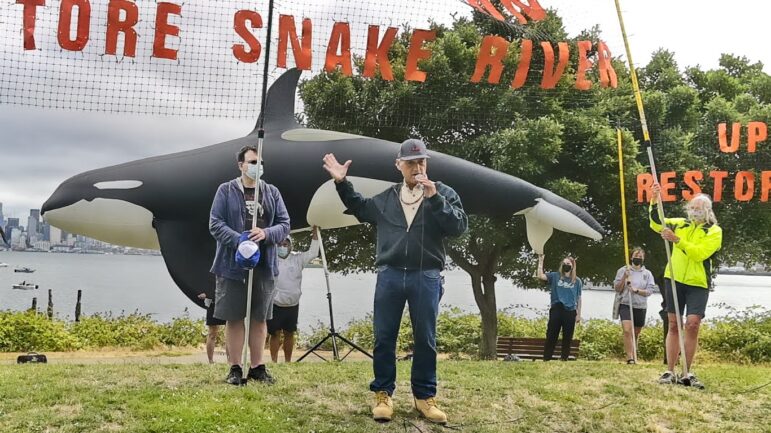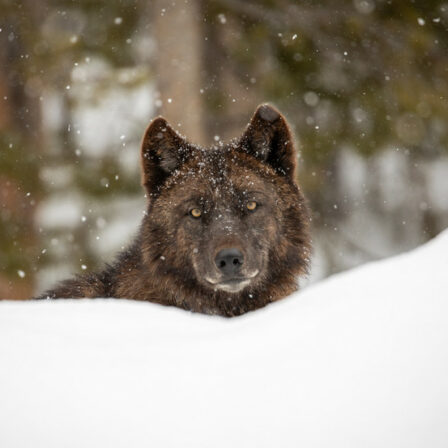Hundreds of people across the Northwest gathered on August 7th to demand Northwest members of Congress save salmon and the southern resident orca that rely on salmon. The coordinated events, called Rally for the River, took place in six cities in Washington, Oregon, and Idaho. Attendees got on the water in kayaks, canoes, floats, and SUPs to highlight the need for a free flowing Snake River. Scientists have said for years that restoring the Snake River by removing four deadly dams is the single most effective way to begin restoring salmon and orca populations.
The Endangered Species Coalition’s Northwest Field Representative, Chris Connolly, along with partner organizations, hosted a Rally for the River in Seattle. More than 40 Northwesterners gathered on the shores of the Salish Sea, the ancient lands of the Duwamish Tribe, holding signs, banners, and giant inflatable orcas. Ken Workman, a member of the Duwamish and great-great-great-great grandson of Chief Seattle, thanked the gathering for their efforts.
Pam Clough, acting director of Environment Washington, highlighted the struggles that salmon currently face in the Columbia and Snake Rivers. Both the Columbia and Snake are currently at temperatures above the cold water threshold that salmon need to survive: 68 degrees Fahrenheit. Just recently a video showed Columbia sockeye with lesions on their body caused by warm water.
President of the board of directors of Orca Conservancy, Tamara Kelley, asked the rally for a moment of silence for the passing of K21 (Cappuccino) who is assumed to have passed away last week. While we cannot say for certain how he died, the lack of food (salmon) for the southern resident orcas makes disease and death much more likely. Tamara spoke to the importance of abundant salmon for the southern residents, including from the Columbia and Snake Rivers which are key food sources.
The gathering then turned to the Salish Sea, home of the southern resident orca and once-abundant salmon populations. More than 20 people climbed into kayaks or stood on SUPs and slipped into the water for a short paddle. Those that stayed on land walked down the street to join up at Jack Block Park, where they watched the paddlers lift a banner on the water with the Seattle skyline in the background.
Nancy Sackman (Duwamish or Lushootseed name Si’qal’qaləx̌ič), another member of the Duwamish Tribe, welcomed the paddlers to shore in the traditional way. Andrew Grueter of the Duwamish Longhouse and Bill Moyer of Backbone Campaign closed out the rally with powerful words, pointing out the negative impacts humans have recently had on important waterways. Emphasizing the importance of following Indigenous leadership they each encouraged us to remember that the power of regular people coming together in bold, principled, and nonviolent action is exactly the force that transforms what seems an inevitable harm impossible, and makes the once politically impossible inevitable.
The Duwamish Tribe remains unrecognized by our governments, yet we continue to benefit from presence, stewardship, and ancestral lands. Please support the Duwamish by signing this petition for their recognition and contributing to Real Rent Duwamish.
Check out some of the media coverage Rally for the River received across the region:
- Seattle KING 5: Conservation groups call for removal of lower Snake River Dams to save salmon, orca
Spokane KXLY: ‘We are going to run out of time’: Community rallies to save salmon - Boise KIVITV: Flotilla raises awareness for the salmon and the breaching of the dams
- Portland KATU: Conservation groups call for removal of Snake River dams, citing concerns for salmon
- Public News Service: NW Heat Boils Salmon, Drives Rallies Across Region
- West Seattle Blog: VIDEO: Rally for the River seeks support for saving orcas by saving salmon via dam-breaching





2 comments on “Rally for the River to Save Salmon and Orca”
I don’t live in WA, but have visited your beautiful state a number of times, thank God my brother lives there as it gives me a better reason to come. Needless to say, I have fallen in love. Not only by the lush trees, cozy weather and pleasant people, but by your waters and the Orcas. I’d like to thank organizations like you who non stop fight to save these amazing wonderful creatures. As part of the human race, I do feel an intense obligation to protect the Orcas and fight for their life. It was such an honor and a privilege to be a part of the Rally for the River . To be amongst everyone that had the same passion and cause and drive to fight and reason and address and hope that the Orcas can be saved. On my next visit, I wish I would be lucky enough to see one in the wild.
An interesting Professional Paper was published in 1986; by Dr. D Chapman, titled: ‘Salmon and Steelhead Abundance in the Columbia River in the Nineteenth Century.’
This Paper was published in the Journal ‘Transactions of the American Fisheries Society.’
The paper’s Figure #1 shows a graph of ‘Total Catches of Chinook Salmon’ from 1868 through 1966. It shows that the ‘maximum annual catch’ of Chinook Salmon, 20 Million Kilograms, occurred in 1883; and by the early 1960’s the ‘annual catch’ had decreased to 2 million Kilograms.
The ‘first Lower Snake River Dam,’ Ice Harbor project; came online in 1962; so therefore the significant decrease in ‘annual catch of Chinook Salmon’ from 20 Million Kilograms to 2 Million Kilograms occurred prior to the presence of any of the Lower Snake River Projects and they therefore had no influence in this decrease in ‘annual catch.’
Perhaps ‘overfishing’ has been a major culprit?